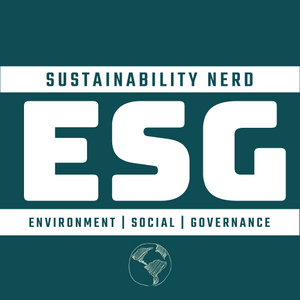Part one: Code Red
Welcome back to ESG Nerd. In this article, I'll share my own experience of witnessing the horrors of ocean plastic, highlight some of the issues causing carnage in our waters and what is being done to mitigate the risks to marine life. You’ll also learn about some of the fantastic work being carried out by groups and individuals across the globe.
Governments face many challenges, from crime prevention to unemployment. In many cases, the environment takes a back seat. Take the United Kingdom. Since 2016, the UK government has dealt with BREXIT and several leadership changes. Then along came the global events of COVID-19. I'd argue the plastic crisis is low on the UK government's agenda. I hope you enjoy reading my thoughts and findings.
October 2018 - Riviera Maya, Mexico. I walked along the beach, eagerly awaiting the sunrise. As the sun rose, I noticed plastic washing up on the beach. Sadly, it wasn't the first time I'd seen plastic washing up on the shores of Mexico's eastern coast during that particular trip.

Image by the author
At the time of my visit to Mexico, I was well aware of the plastic emergency threatening our oceans, rivers and marine life. To put things into context, I did not recall seeing plastic waste washing up on the shoreline during my Mexico visits in 2008, and 2012.
Behemoths of the hospitality world continue to offer single-use plastics to their customers. Arguably, sustainability is absent from the minds of tourists, especially in resorts where sun, food and relaxation are the primary purpose of their visit. Hotels must do more to reduce single-use plastics when humans are in carefree mode - how to make tourists responsible for their own actions is a challenge. Many of those plastic cups end up in the ocean, rather than in the bin.
Education is arguably the key to raising awareness. One solution is for airlines to assist with a positive message. They could do this by showing educational videos, like the ones I've mentioned in this post. Do you think air passengers would take notice? Let me know on Twitter.
Raising global awareness of a human-made problem
It took the work of David Attenborough's Plastic Oceans to raise global awareness. Every time I see a piece of fish for sale I ask myself whether the meat is contaminated with microplastics.
Researchers have found high volumes of microplastics in the stomach, liver and fillet of many species of fish. One study estimated that 35,000—62,000 microplastics are inhaled annually by the average adult. Search Google for ocean plastic waste and you'll find some horrendous images of an existential catastrophe.
Just how bad is the problem, and why have I chosen the subject of 'Ocean Emergency' as my first focus for ESG Nerd? Under the UN's 17 Sustainable Development Goals - Goal 14 is 'Life Below Water' - conserve and sustainably use the oceans, seas and marine resources for sustainable development.
According to McKinsey Insights (2015), on current trends, the global quantity of plastic in the ocean could nearly double to 250 million metric tons by 2025, or one ton of plastic for every three tons of fish. We cannot continue in this way.
Per Futurism publication, one study estimated that our oceans will contain more plastics than fish by 2050. The WWF claims annually, over 8 million tonnes of plastic enter our seas. That's a depressing stat. Preventative measures, education, and action are the cure. Easier said than done. Time, collaboration and funding is needed to address the 'Ocean Emergency' a situation that must be brought under control as quickly as possible.
Why didn’t global R&D departments of consumer products threatening marine life didn't ask the question of what would happen at the 'end of the life'? Did they assume it would go to a landfill? That's a debate for another day, especially when you consider there are many developing countries with emerging waste-management systems.
Increased GDP in South East Asia generates increased demand for consumer goods
Where do you think the majority of plastic enters the ocean from? Research by McKinsey suggests that the majority of plastic enters the ocean from South East Asia. The reason is due to a rise in GDP in five countries; China, Thailand, Philippines, Vietnam and Indonesia. Those governments would benefit from a consultation with European waste-management experts. I keep banging on about 'collaboration' and here’s a prime example where experts must share industry knowledge with developing nations.
Case Study - Osborne Reef
The Osborne Tire Reef is an artificial reef off the coast of Fort Lauderdale, Florida. The project is a great example of innovation and good intentions going wrong. I'll briefly hand you over to 4Ocean to describe why the United States sponsored a ‘high risk’ marine project.
In the early 1970s, a nonprofit group founded by fishermen suggested using the tires to expand an artificial reef off the coast of Florida. It was believed that the tire reef would encourage new coral growth, attract more big game fish, improve local biodiversity, and benefit the local economy. The idea garnered widespread public support and was eventually endorsed by state and local governments as well as the US Army Corps of Engineers. - 4ocean
Unfortunately, saltwater corroded the nylon restraints, allowing the tyres to collide into nearby natural reefs. Marine life, some of which is near to extinction rely on reefs for refuge and food, so it's imperative clean-up efforts in the region continue. The Osborne Reef threatens the local ecosystem, and thankfully the heroes at 4ocean are doing their best to recover the enormous carpet of used car tyres.
Budget cuts, extreme conditions and stray tyres in their hundreds of thousands have hindered progress in the efforts to recover tons of rubber from the ocean bed. But like ESG Nerd, moving forward is the only option. After all, our magnificent sea creatures can't clean up our mess. I often wonder what our oceans would look like if huge corporations invested money in our planetary crisis, rather than trying to conquer space travel.
In my welcome note, I stated that I was not affiliated with any charity or organisation - should you wish, you can donate to the Osborne Reef clean up.
💡Did you know? Barcelona will host the Sustainable Ocean Summit on 17&18th October 2022. Here's a highlight from the 2019 summit.
There is a real need to drive forward ocean investment opportunities to offset the one trillion dollars per year in economic losses due to poor ocean management – from overfishing to pollution to invasive species. Restoring marine ecosystems, including through innovative public-private partnerships, can generate enormous new economic activities. – Achim Steiner, Administrator, United Nations Development Programme (UNDP)
Cooks River, Australia
Pollution is indiscriminate. Thousands of miles away from Osborne Reef lies Cooks River, Australia. The 23-kilometre urban water flows into Botany Bay, at Sydney harbour. Yes, you guessed it, the river is a vessel for waste to enter the oceans.
I first learned of the Cooks River problem only recently, thanks to Beau Miles's YouTube video, Bad River. The situation down under is one of many chapters of polluted waterways. In 2021, flash floods washed thousands of plastic bottles onto the shores of Cooks River, all destined for the deep waters of the South Pacific Ocean.
Ocean pollution goes beyond plastic - The DuPont debacle
Run off from agriculture, storm water and waste treatment plants contribute to ocean pollution. Perflouroalkyl and Polyflouroalkyl, known as PFAS (forever chemicals) are widely used in many products, including makeup and Teflon pans. Netflix's Dark Waters movie depicts efforts by a lawyer who takes DuPont to task over the company's extreme polluting of waters in New Jersey.
NBC's March 01, 2022 article discussed whether DuPont had found a way not to pay reparations for their catastrophic actions. NBC claimed DuPont offloaded its PFAS obligations to smaller companies that do not have the capital to pay for them. I wonder how the scientists behind PFAS slept at night, knowing their volatile creation could do so much damage to the planet.
In July 2021, two US Senators introduced the Clean Water for Military Families Act and the Fifty Fifty Act. Both legislative acts direct the US Defense Department to identify and clean up PFAS chemicals at U.S. military installations. A US Government Accountability Office report claims PFAS clean-up costs could top £2.1 billion. On Friday, DuPont's share price soared to $61.09.
Fast forward to June 2022, the US Environmental Protection Agency announced advisory limits for four kinds of PFAS, warning that the compounds are more toxic than previously thought.
The situation looks bleak for marine conservation. In part two, I’ll be discussing innovative ways of tackling the global ‘plastic soup’.
Thank you for reading ESG Nerd.
Find me on Twitter and Instagram and join in on the conversation - #ESGNerd
